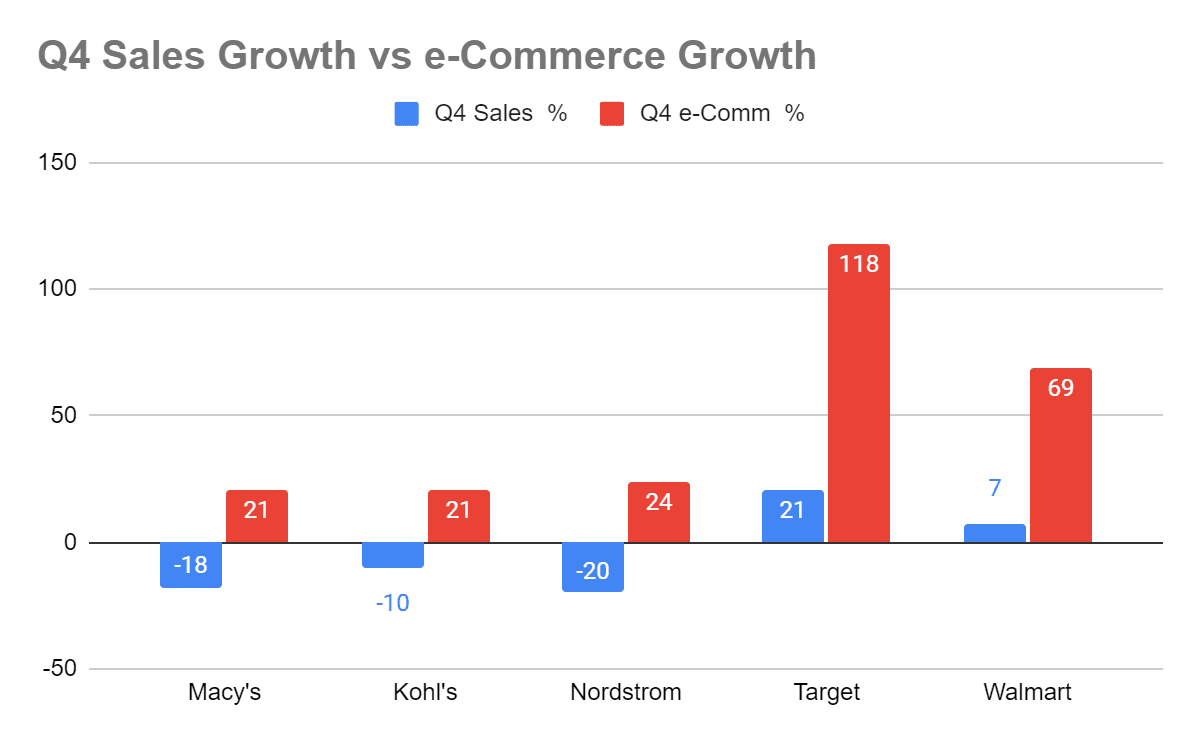
Following a quarter — and year — in which digital retail sales and alternative order fulfillment options like curbside pickup and BOPIS (buy online, pick up in-store) surged, retailers of all sizes and styles are understandably looking to grow those practices again in 2021, but will be facing tougher comparisons as the year progresses.
Although the second quarter of 2020 marked the trough for most retailers, the third and fourth quarters reflected ongoing adaptation to health-related restrictions on shoppers and the changing tastes of consumers who felt safer buying online.
It was also a quarter in which several national brands began to truly tout the benefits of their brick-and-mortar locations, which not long ago had been viewed more as costly and outdated liabilities compared to their faster-growing and more efficient digital counterparts.
Nowhere was the omnichannel mantra more pronounced than at the country’s largest sporting goods retailer. “We see our in-store and our online experience as one – our stores fulfilled 70 percent of our eCommerce orders in the third quarter,” a spokesperson for DICK’S Sporting Goods said last month in an email to PYMNTS.
Similarly, Macy’s CEO Jeff Gennette, who avoided referring to his company as a department store during the most recent earnings call with investors, now identifies as a “digitally-led, omnichannel retailer” instead.
Tougher Digital Comps
Although Macy’s net sales fell 18 percent for the three months ending Jan. 30, Gennette said that 44 percent of net sales came from digital transactions, 25 percent of which were fulfilled by stores.
 Although the operator of 750 stores saw its Q4 digital sales rise 21 percent, that was down from the 27 percent pace it saw in the third quarter.
Although the operator of 750 stores saw its Q4 digital sales rise 21 percent, that was down from the 27 percent pace it saw in the third quarter.
Similar quarter-on-quarter contraction of eCommerce growth rates was also seen at Kohl’s and Nordstrom, which went from 25 to 21 percent and 33 to 24 percent, respectively.
“Our fourth-quarter performance exceeded our expectations across all key metrics with sales strengthening,” Kohl’s CEO Michelle Gass said in a Feb. 4 statement, noting a 21 percent increase in digital sales, which accounted for more than 40 percent of total revenues. “As we carry this momentum into 2021, we are confident that our key strategic initiatives will accelerate our top-line growth and expand our operating margin,” she added.
While the biggest broadline retailers are clearly much further along in their digital transformation and integration, Target and Walmart also experienced slowing digital growth rates. Not that anyone was disappointed by Target’s Q4 digital increase of 118 percent, but it was 35 full percentage points lower than its Q3 result. At the same time, Walmart saw its Q4 digital sales growth in the U.S. slow to 69 percent from 79 percent in Q3.
Digital Still Dominates
As much as the quarterly comparisons will start to get tougher in April, those results won’t be out until late summer. Until then, the digital commerce story is still the dominant trend in retail and shows no signs of abating, from either customers or management. A glance at the Q4 total sales versus eCommerce sales shows outperformance by the online arena across the board. That’s backed by company commitments to spend more on technology and automation to streamline the selling and delivery process and to improve everything from the supply chain to customer loyalty and experience.

On the one hand, Walmart led all others in announcing a 20 percent increase in its capital expenditure budget this year, via plans to invest $14 billion into its worldwide retailing enterprise of 10,500 stores, under 48 banners in 24 countries, as well as eCommerce websites.
At the other end of the e-retailing spectrum is the announcement last week by Saks Fifth Avenue’s Canadian parent firm Hudson’s Bay Company that it is spinning off its Saks.com eCommerce business into a standalone company from its 40 luxury brick-and-mortar stores, saying that the resulting split would create “separate but related sisters.”
There are also other corners of non-store retail sales that are set to grow again this year, including streaming commerce, social media selling and virtual try-ons and appointments.